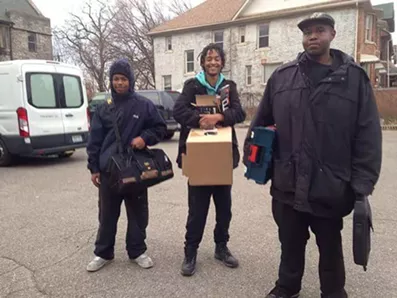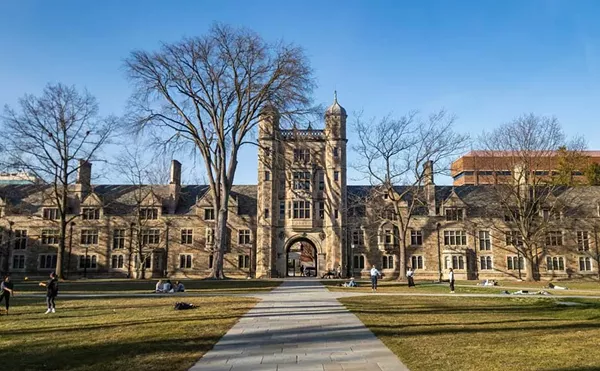
On a chilly November evening the neighborhoods of northwest Detroit are quiet — traffic on Grand River Avenue is unusually calm, and the area's residential streets are mostly dark — but the Detroit Public Library's Redford Branch is buzzing. An hour before closing time the building's wraparound parking lot is nearly full; inside, dozens of patrons, men
"This is kinda shaky today," LC Bulger, a soft-spoken 53-year-old, says as he tries multiple times to log off. Bulger has sporadic web access through his job working in special education for Detroit Public Schools, but he has no access at home. So tonight, when he needed to process some emails and do other personal work, he came to Redford.
"This is a light night," he says — sometimes when he shows up all of the computers are taken, and he'll go home rather than wait, reasoning that schoolkids and other patrons have
By now the disparities of Detroit's comeback are well documented: Despite a feverish economic surge centered downtown, most neighborhoods are still struggling; the city ranks as both America's most impoverished large city and
In a time where equal access to the internet nationally appears under threat — last month President Donald Trump's Federal Communications Commission declared its intention to gut net neutrality — approximately 40 percent of Detroit households remain completely offline, even as slick new providers like the Dan Gilbert-founded Rocket Fiber emerge to keep pace with the city's frenetic development. And for the hundreds of thousands of residents left unconnected, the consequences are stark.
"This is now no longer a problem of lost opportunity — this is a problem of a genuine barrier," says Bill Callahan, director of the nonprofit Connect Your Community. "In many
Broadband service throughout most of metro Detroit is dominated by two main providers, Comcast and AT&T. Comcast's most basic internet-only plan, through its
After entering agreements with the FCC that the agency sought as conditions of the companies' past merger deals, both AT&T and Comcast now offer discounted broadband plans for qualifying low-income Detroit residents who live in areas where the service is available: AT&T's Access plan costs $10 a month where the connection speed is 5 to 10 megabits per second and $5 a month where the available speed is slower; Comcast's program, Internet Essentials, which the company says currently serves 13,000 low-income Detroit families, costs $10 a month for a 15 Mbps connection and also includes an option for a $150 computer.
Rocket Fiber, originally conceived of by Quicken Loans' employees as a new lightning-fast internet connection for Detroit and backed by Gilbert, launched in early 2015. The company advertises its
For a number of reasons — unavailable broadband infrastructure, a lack of digital familiarity or interest, or costs that are still prohibitive — a large swath of Detroit's population remains offline: a 2015 report cited by the FCC, relying on Census data, found that 100,000 Detroit households, representing 40 percent of the city's population, had no internet connection of any kind, including mobile. Fifty-seven percent of households had no hardline connection, and 70 percent of the city's school-age children had no internet access at home.
"Detroit's digital divide is among the most extreme in the nation," Tom Wheeler, the FCC chairman under President Barack Obama, and FCC commissioner Mignon Clyburn wrote the same year after a visit to the Motor City. "The bottom line is this: If you are not connected to the internet in 2015, you cannot participate fully in our economy and our democracy."
A 2015 report cited by the FCC found that 100,000 Detroit households, representing 40 percent of the city’s population, had no internet connection of any kind.
tweet this
The developed world has, in fact, gone almost completely digital: Whereas 15 or so years ago online connectivity and digital fluency may have still been a sort of privilege — it was helpful, but not necessary, for everyday tasks like paying bills or searching for a job — at this point there's a near-consensus it amounts to a basic right in modern life. In 2015, Obama, announcing a new connectivity program, declared "the internet is not a luxury, it is a necessity"; as far back as 2011 the United Nations called
"Go into a dollar store," says Callahan. If you're applying for a job, "they want you to go sit at that computer." Imagine applying for college without using the internet, or assessing health care options, or keeping up with local politics. "Every time somebody pushes another important [aspect of daily life] over to the internet, which is happening constantly,
And while Detroit's digital divide may partly be born of individual economics — lower-income families don't buy service because they can't afford the bills — it's also exacerbated by digital infrastructure that's far worse than other large cities' infrastructures.
"Because of high foreclosure rates, and because of bad credit, a lot of telecom companies don't offer good service within these areas," Diana Nucera, director of the Detroit Community Technology Project, told Vice's Motherboard on the city's internet connectivity. "Or they won't even turn on their fiber. So we have a lot of dark fiber that doesn't have internet running through it throughout the city."
Part of the infrastructure gap, critics say, can be attributed to discrimination. In a practice reminiscent of the 20th-century mortgage redlining that effectively segregated Detroit, comprehensive analysis by Callahan and the National Digital Inclusion Alliance, which includes 297 affiliates in 37 states, determined that over the past decade AT&T has systematically implemented new Internet technology in wealthier southeast Michigan neighborhoods while neglecting poorer ones — a profit-driven strategy that Callahan says violates non-discrimination laws and amounts to "digital redlining."
Callahan is based in Cleveland. Beginning in late 2015, while trying to help Clevelanders sign up for AT&T's Access program, he realized many
"These were executive decisions to build somewhere and not build elsewhere," says Callahan. "This could not be clearer that it's discrimination based on the basis of income. It happens also to be on the basis of race. ... I actually was quite shocked the first time I saw it."
In September, the organizations released a similar map of Wayne County. The effect was identical: Suburban areas including the Grosse Pointe communities, Livonia, and Westland were equipped with internet speed of at least 18 Mbps, as
Later that month Daryl Parks, a Florida-based civil rights attorney who represented the family of Trayvon Martin, filed a complaint with the FCC on behalf of two Detroit residents against AT&T. The service analysis "demonstrates that AT&T withheld fiber-enhanced broadband improvements from most Detroit neighborhoods with high poverty rates, relegating them to internet access services which are vastly inferior to the services enjoyed by their counterparts nearby in the higher-income Detroit suburbs," the complaint alleges.
The company has pushed back against suggestions of discrimination. AT&T's "commitment to diversity and inclusion is unparalleled," Joan Marsh, the company's external affairs officer, said in a statement following the Detroit complaint, the Dallas Morning News reported. "Investment decisions are based on the cost of deployment and demand for our services."
Still, Callahan emphasizes, "they have never once questioned a fact."

On a visit earlier this year to a home in Islandview, an East Side neighborhood that's among Detroit's poorest, Dwight Roston, equipped with his cables and other gear, found a woman who had bought a brand new computer months earlier but never taken it out of the box. Also home were her college-age daughter and three young boys. The family had never had internet access before; after a couple
"The thing about Islandview is that people here are used to not having what we need," says Roston. "I know people who have to take the bus in the cold or the snow or the rain to make it to a library." So when someone is finally able to just log in from home, Roston adds, "it's a relief. You don't have to work so hard."
Roston, now 23, grew up in the same neighborhood, in a home that never had internet. At King High School, he says, online opportunities were also rare. Initially inspired to dive into technology by his musical ambition, he began using the equipment — and teaching himself video and music production — at the Church of Messiah's BLVD Harambee Empowerment Center, which includes a popular computer program. "In this particular area," says Wally Gilbert, the program's director, "no, they really don't have anywhere else to do that."
Roston is now a digital steward with the Equitable Internet Initiative, responsible for installing wireless connections for Detroit residents. Since last summer, the
Recipients use their new connectivity in different ways — some are primarily interested in research or entertainment, others are using the web to grow their own small businesses — but the need for connectivity is widely recognized, says Monique Tate, a digital steward who works in the North End. "Everyone realizes it at a practical level," she says. "People get it, and they understand that there's potential."
And organizers also emphasize the need for real speeds. "Our Equitable Internet Initiative can't stop
Yet the program's scale is relatively small: In each of the three neighborhoods it serves, the aim is to connect some 50 homes, which are selected based on internet requirements, financial need, and proximity to EII's antennas' range. Other community programs, like BLVD Harambee, can help fill in the gaps, but for many
"An essential part of this is digital literacy," says Tate. "Connection is the key, and it's






